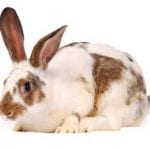Scientific Facts
| Common Name: | New England Cottontail, gray rabbit, wood hare, brush rabbit, cooney |
| Scientific Name: | Sylvilagus transitionalis |
| Life Span: | 3 years |
| Size (Adult): | 398 to 439 mm |
| Weight (Adult) | 995 to 1347 grams |
| Habitat: | Forests, dense vegetation, woodlands |
| Body Shape: | Small and compact |
| Country of Origin: | New England, USA |
Physical Description
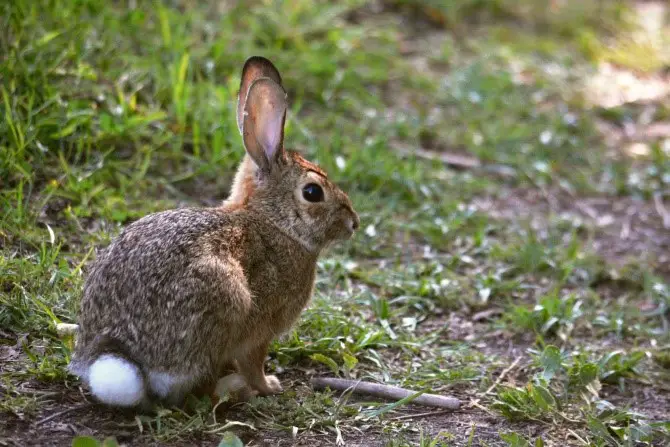
The New England cottontail rabbit is a cottontail rabbit that’s represented by rabbits found in New England from southern Maine to southern New York. This rabbit breed looks very similar to the New England cottontail, which may have been introduced to the home range of the New England cottontail. Because of this, the New England cottontail is now more popular than the New England cottontail.
Over the years, the population of the New England cottontail has dramatically decreased, and this has led to its “Vulnerable” classification by the IUCN Endangered Species Act. Also, cottontail hunting has been restricted in some areas where the New England cottontail and the New England cottontails are located.
The New England cottontail is a rabbit with a medium body and appearance that’s similar to the New England cottontail. Most breeders say that the only way to distinguish a New England cottontail and a New England cottontail is by getting a DNA sample, by fecal sample and by examination of their skulls.
When the skulls of a New English cottontail and a New England cottontail are examined closely, the frontonasal sutures of the New England cottontail are smooth while those of New England are jagged. The New England cottontail comes with black hair between the ears while this is not present in New England cottontails.
Conservations
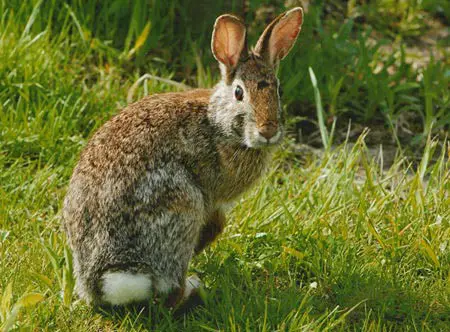
The New England rabbit has been classified as vulnerable by the IUCN since 1996. This rabbit species are protected by the federal Endangered Species Act and is included in the list of endangered species on a state level in Maine and New Hampshire.
The New England rabbit is also listed as vulnerable due to its decreasing population and the reduction of its habitat. The United States Fish and Wildlife Service. Because of its rarity and elusiveness and the fact that it looks very similar to the New England cottontail, it is very hard to get accurate data as to the exact number of New England cottontail; present in an area.
In 2013, the State of Connecticut had started a restoration project of this rabbit’s habitat in Litchfield County. The project cleared 57 acres of woodland to create a second-growth forest and a meadow that New England rabbits will love to live in.
Fast Facts
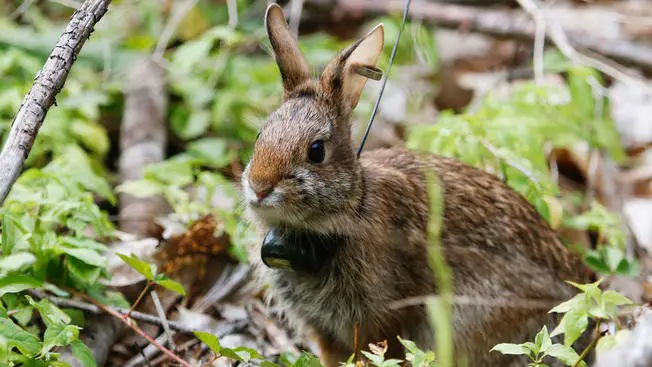
The New England cottontail is described as a habitat specialist because it can thrive in young forests or forests that are less than 20 years old and in dense and thick vegetation. Experts say that the areas where the New England rabbit thrives have matured into close canopy strands, and the shrubs have begun to thin during 1960. This was when the population of this rabbit began to decline.
Reproduction

New England Cottontails reproduce two to three times a year. The testes of the male rabbit start to enlarge in December. The breeding season changes depending on the local elevation and latitude, and this can happen from January to September.
The breeding season in Connecticut starts from mid-March to mid-September, while the breeding time in Maine starts from April to August. The pregnant doe appears between April to August. The gestation period is about 28 days.
The litter size has an average of 5.2 kittens. Cottontails that live in northern areas have shorter gestation periods but have larger litters. These rabbits will produce more kittens during the warmer months.
During the mating season, male cottontails start breeding groups with a dominant female. The group creates a den that’s near their food source and where there’s a good cover. A “courtship display” happens where the rabbits jump after on another. The linear hierarchies of New England cottontails are not defined, but once a male and female are paired off, the female becomes dominant to the male as they create nests during the birth and while nursing.
New England cottontails may mate again after birth and thus can become pregnant soon as well. Similar to most cottontail species, the New England cottontail has a short lifespan. Experts report that this rabbit may only survive three years in the wild. Also, an average of only 15% of babies survives their first year.
New England cottontails can reach sexual maturity in no more than a year, and usually, young New England cottontails will reproduce in their first year. Babies are usually born blind and vulnerable, but the mother does not take care of them like other animals. The female cottontail will nurse their young for 15 days, and after the doe has mated again, it will lose interest in nursing her older babies.
Personality and Behavior

New England cottontails are solitary animals, and the only time that they socialize is during breeding. This rabbit is active between dusk and dawn and thus will remain inside their burrows during the daytime and forage during nighttime.
This rabbit is silent and may communicate using soft grunts and may also purr in contentment. They are also known to thump the ground using their hind feet. If the rabbit is caught by a predator, it will scream in a sound that’s similar to the yelp of a pig.
When escaping a predator or shielding itself from bad weather, the cottontail will use any convenient shade or human-made cover. It may even go inside an old burrow or abandoned burrow. This rabbit does not hibernate but is very active all year long.
Comparable Breeds
The New England cottontail is comparable to the New England cottontail. It is the most common wild rabbit species in North America and can be found in meadows, shrubs, and in thick forests. The two resemble each other physically, and the only way to distinguish one from the other is by a thorough examination done by a vet or a professional.
Care of New England Cottontails
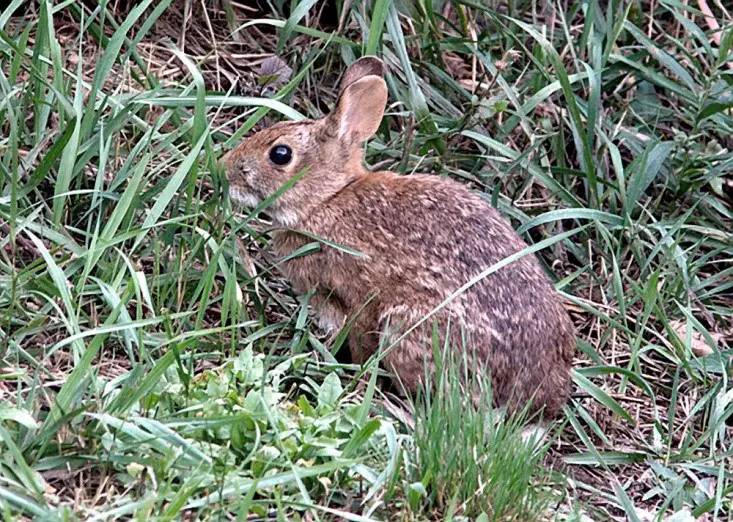
A New England Cottontail is a wild rabbit breed; therefore, it is a skittish and nervous breed. Before we head to the different ways to care for this rabbit, take note that this is only for information and is solely based on a captive-bred, once-wild rabbit. Never get a rabbit from the wild to tame it.
Basically, caring for this breed is like caring for other breeds. You must always provide the right diet, housing or enclosure, correct medical treatment, and companionship.
A vital part of a rabbit’s daily diet is hay, but you may also provide other food like rabbit pellets, which is commercially-prepared food with vitamins and minerals for your rabbit’s good health. Include vegetables and fruits to their daily diets for a healthy, well-rounded diet.
Put unlimited fresh water and hay inside the enclosure. Hay is an important part of a rabbit’s diet because this is rough and can help keep their digestive systems regular. You may also use ana inverted water bottle for a spill-proof way to drink.
Your pet should be eating the safe and right kind of food. Avoid producing with pesticides, toxins, and chemicals by feeding it organic fruits and vegetables instead. Also, younger rabbits may be fed with alfalfa hay because it’s rich in calcium for growing bones. Also, adult New England Cottontails will eat legume hay, which is easier on the stomach.
Captive-bred New England Cottontails can be trained to remain calm and friendly, but you must invest a lot of time and effort to train it very well. You must constantly interact with your pet rabbit. Consider that rabbits are social animals and thus will need companions other than playing with their owners. Rabbits that grow up with constant companions and regular interactions with their owners are known to be healthier, happier and will live longer than those left in cages without any companions.
New England Cottontails may be wild rabbits but are very meticulous groomers and will groom themselves for many hours. Rabbits may also groom each other, and this a way to bond with their companions. You may also see mother rabbits grooming her babies, which are usually done right after giving birth.
New England Cottontails are very active in the daytime and sleep in the evenings when kept in captivity. Therefore, you must feed your pet New England Cottontail in the morning when they are most active. Captive rabbits can sleep 8 hours a day and may sleep closely together to keep themselves warm and comfortable.
Supplies and Cages
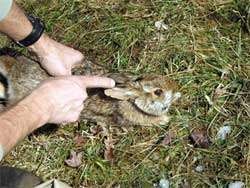
New England Cottontails are very energetic and will need a larger outdoor enclosure than a domesticated rabbit. This cage should be made of wire and should have aa strong frame. This rabbit can escape by burrowing, kicking the cage, or destroying the screen, so keep your enclosure well-constructed and strong.
The floor of the enclosure should have soft bedding and lined with good quality bedding. Place a rabbit hay feeder on the side of the enclosure and fill this with hay. The rabbit can eat when it is hungry, or it just wants to chew on hay all day. For bedding, use hay, wood pellets, or horse bedding.
A rabbit’s cage should be maintained regularly. Start by removing your pets and placing these in a safe and clean cage. We recommend only a safe cleaner or natural cleaning product like vinegar, baking soda, or lemon so your pet will be safe. Don’t use household cleaners because these could have dangerous chemicals that will affect your pet’s health.
Have a separate or extra cage to take care of baby New England Cottontails. Baby rabbits are born naked, deaf, and blind and, therefore, must have a warm enclosure to keep their bodies at the right temperatures. A smaller cage with cage lamp or lighting will work fine to keep the kits dry, warm, and safe.
Like other breeds, New England Cottontails love chewing on anything that it sees. If these rabbits are placed indoors, these will chew on anything made of wood and light materials, and it can also chew on electrical wiring. You must keep your home rabbit-proof before releasing your pet from its cage. You may also use a removable fence or screen to shield the rabbit from dangerous areas in your home and in your yard.
Also, cottontails can be hosts to different pests such as lice, ticks, fleas, cestodes, trematodes, nematodes, botfly larvae, tularemia, torticollis, and streptothricosis. Because the cottontail is a host to these pests, you must never take an eastern cottontail in the wild.
The longest-lived specimen in the wild is five years of age. Meanwhile, captive specimens can live longer.
Wild animals that eat baby cottontails include badgers, raccoons, skunks, and opossums. The cottontails in Missouri are a staple in the diets of hawks, especially during the nesting period. This rabbit is a major component in the diet of great-horned owls.
Baby cottontails are very vulnerable, and because the mother returns only twice a day to feed them, the nest is open to many types of predators.
The eastern cottontail has several predators that are natural or introduced to their natural environment. Because of their large numbers in eastern North America, cottontails have a major component of many predators’ diets. The major predators o this rabbit include common housecats and dogs, coyotes, foxes, weasels, barred owl, great horned owl, hawks, snakes, bobcats, raccoons, minks, fand corvids.
Predators of the Eastern Cottontail
During the summer, cottontails will eat green herbs if these are available. Cottontails are also active during the cold season. This is when green vegetation is covered with snow. These rabbits will consume twigs, buds, and barks of woody plants and tall trees.
Some cottontail breeds will produce two kinds of droppings, and one of these is eaten. This is said to increase the nutritional values of many dietary items included on rabbit droppings.
In the wild, the cottontail has a varied diet, and it depends on the availability of food. These rabbits eat vegetation. The natural diet includes barks, leaves, fruit, flowers, twigs, seeds, rush seeds, fruits, and grass seeds of almost all kinds of plants in its habitat.
Health Concerns
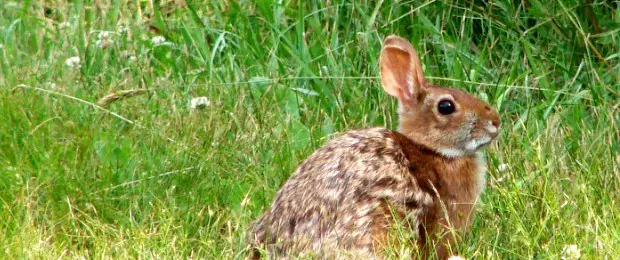
A New England Cottontail is a healthy breed and is not affected by any particular disease. And the most common condition that this rabbit may be affected with is common pests like mites, ticks, and fleas. These pests are naturally found in their environment.
On the other hand, New England Cottontails are not immune to common rabbit illnesses. This is why you must monitor your rabbit’s health and temperament. Any kind of changes in the rabbit’s physical and mental condition may be due to an illness. As early as possible, take it to the vet for vaccinations and tests.
The vet will subject your pet to tests to assess the overall health and development of the rabbit. The vet will also rule out certain diseases that affect young or small rabbits like digestive tract conditions enteritis, bloat, and stasis.
Also, take note of ear or fur parasites (mites, fleas, and ticks) because these can make your rabbit very uncomfortable and may also bring other medical conditions. Rabbits with these parasites usually have poor hygiene and are caged in dirty surroundings or enclosures.
Check your rabbit for signs of illness such as poor appetite, nasal and eye discharges, diarrhea, and vomiting. Other symptoms like unsteady gait, restlessness, teeth grating, and sleeping for extended periods because these may be a serious condition.
Another important part of caring for rabbits is deworming. A wild or captive-bred rabbit must be treated for worms at least twice a year, and this must be done during spring and fall. Don’t forget deworming since this is a major concern with rabbits that are from the wild or other wild parents
All rabbit breeds must be dewormed at once. Use a pea-sized deworming paste and place this in the rabbit’s mouth. This will lick and swallow the medication until it’s gone. You must follow the dose depending on your vet’s prescription.
Dental Care
A rabbit’s teeth will grow continuously, and sometimes, this can grow very long that it can hurt their mouth and gums, causing so much pain and discomfort. Therefore you must make sure that the rabbit’s teeth will not overgrow to avoid these complications. Help your rabbit by offering hay since this can grind the rabbit’s teeth naturally while the rabbit chews. You may also place blocks of wood, baskets, or other toys and accessories to stop the growth of the rabbit’s teeth. You must constantly monitor your rabbit’s dental health to avoid expensive dental bills.
Spaying or Neutering
Rabbits should be spaying or neutering to avoid overpopulation. Spaying and neutering must be done at a young age. But some vets prefer to wait until the rabbits are six months to do this. New England Cottontail bucks are also neutered at an earlier age because experts say that neutering can reduce aggression. So, for any question about spaying and neutering, consult your vet.
Grooming
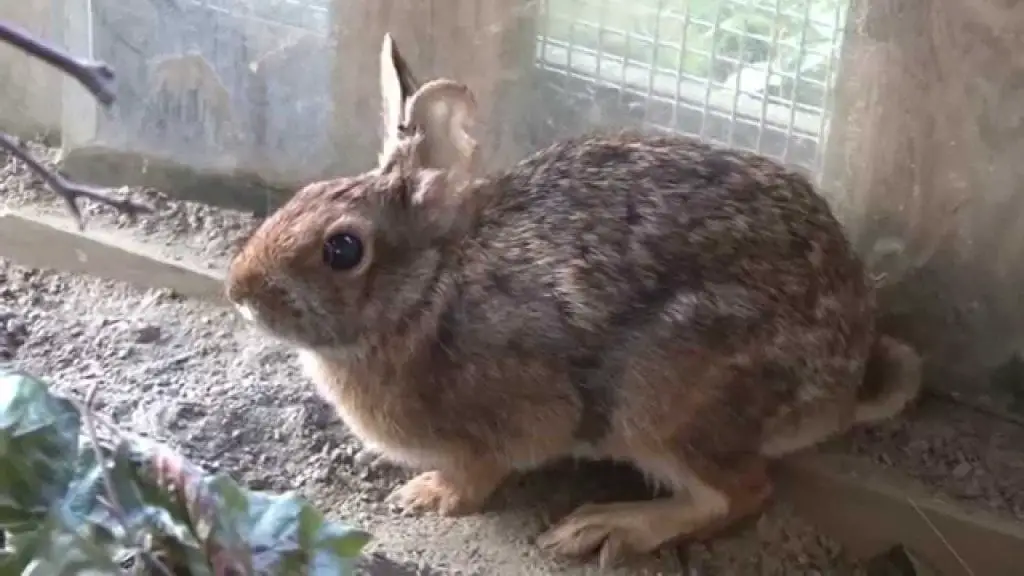
A captive New England Cottontails have very short and rough furs. But no matter what, it will need regular grooming. Use a sturdy brush to groom the fur. Groom at least once or twice a week.
Grooming must be done more frequently during the molting period, which is when the rabbit sheds its old fur to make room for new fur. Grooming removes wool blocks and keeps the rabbit from ingesting their fur. The wool block usually leads to impaction and severe complications when overlooked.
Don’ bathe your rabbit since this can cause stress. Use a damp towel to spot clean the dirt. Just wipe the rabbit down with a damp towel and use a dry towel to remove any excess water. Don’t forget to trim the nails and clean the rabbit ears.
Availability – Where to Get One?
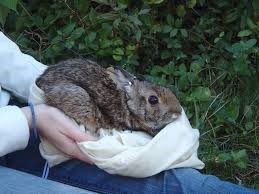
You won’t be able to find a New England Cottontail from a pet store or an online pet dealer because this is a protected species. The only way to care for this animal is to volunteer in a wildlife sanctuary or a nature park. Also, if you find a rabbit in the wild, such as a New England Cottontail, call animal services because you need an expert and professional service to handle this rabbit.
How to Care for a New England Cottontail
We don’t recommend getting a wild rabbit from the forest and taking care of it. If you must care for a New England Cottontail as a part of your work or duty, then this guide can help you.
This is a summary of how to care for a New England Cottontail breed. Caring for this rabbit includes providing the correct diet, housing, companionship, and vet care. When it comes to providing the rabbit’s correct diet, the main food is hay.
Hay is important to grind their ever-growing teeth, keep their digestive system healthy, and keep their regular bowel movements. Another ideal food is a rabbit pellet with added nutrients, vegetables, and fruits to create a well-rounded diet. You may also provide food in their natural habitats such as grasses, seeds, barks, twigs, birch, and weeds, for example.
Always keep water and hay in the rabbit’s cage. Be sure to place water in a large, heavy, and shallow dish so the rabbit can drink from it readily without spilling even if it moves around its cage.
Captive-bred rabbits can only become a friendly and docile pet when you take time to train and bond with it. You must interact with your pet daily. Also, since rabbits are social animals, it will need a rabbit companion or some companions.
So, if you don’t have the time, space, and patience to care for two or more rabbits, then you might just settle with another pet. Take note that your rabbit can grow healthy, and have a good temperament when it socializes with you and his cage mates.
Don’t forget to take the rabbit to the vet early for its vaccinations and tests. A rabbit must be given a clean bill of health before it is allowed to be with other rabbits, pets, and other people. Also, understand the different signs of illness in rabbits so you can take your rabbit to the vet at once.
FAQs
What do New England Cottontails eat?
New England Cottontails are wild rabbits and are herbivores, and it will eat plants. This rabbit will eat all parts of the plant, such as roots, bark, seeds, weeds, flowers, and leaves. It can eat commercially-prepared rabbit food, vegetables, seeds, and fruits when in captivity.
Can New England Cottontails swim?
Yes, New England Cottontails can swim but may not be as good as other water animals. This is different from the domesticated rabbit since these do not want to get wet and will not like a bath. Bath time stresses them.
How do you tame a rabbit?
You won’t be able to tame a wild rabbit because you might end up getting bitten and hurt, plus their wild side will always shine through. You may train a captive-bred rabbit instead because most of these have a calm and docile behavior and have a friendly-disposition than their wild counterparts.
Should you rescue a wild rabbit from the forest?
Never rescue a wild animal such as a rabbit from the forest. If you see an injured rabbit, call animal services for immediate.
Are New England Cottontails endangered?
Yes, the New England Cottontails are threatened species. New England Cottontails are wild rabbits that live in areas that are currently being destroyed for food, logging, and human housing.
Are New England Cottontails territorial?
Breeders say that New England Cottontails are territorial, and this may still hold true when they are captive bred. The rabbit can become territorial when these are kept in a small enclosure. Males can have aggressive behavior and may become very dangerous, especially during the breeding season. The aggressive males will bite, scratch, and kick other males to fight for hierarchy.
How do you maintain a New England Cottontail’s cage?
Remove the rabbit inside the cage and secure it in a separate clean cage. Remove the pan under the cage and dispose of the rabbit poop properly. Brush with water and cleaning products, the cage walls, bottom, accessories, and toys. Replace the cage bedding and make sure that everything is dry before you return the rabbit inside its cage.
Will New England Cottontails eat fruits and vegetables?
Yes, New England Cottontails will eat all sorts of plants and may even eat fruits and vegetables. And aside from these, you may also feed your New England Cottontails rabbit pellets or rabbit food, which has nutrients for your pet’s good health.
Will New England Cottontails eat their poop?
Yes, like all rabbit breeds, the New England Cottontail will eat its dropping because these still have nutrients in them. But after this once, they won’t do it the second time. No one knows why rabbits do this, and you can prevent this by removing their droppings as soon as you see them.
Where do New England Cottontails live?
New England Cottontails are not found in the wild because these are domesticated rabbits. New England Cottontails live in human areas and commercial areas such as breeding kennels, pet stores, and also in human homes as pets. For New England Cottontail pets, these may be housed in large indoor or outdoor cages, preferably in groups for companionship.
Is it legal to own a New England cottontail rabbit?
In some places, this rabbit is considered illegal to own or keep a New England cottontail rabbit at home while some allow it because it is considered a game. If you don’t know the regulations in your area, consult a local animal bureau in your area.
Where do cottontail rabbits live?
Rabbits like the cottontail rabbit burrow into the ground where it can remain hidden from the prey, sleep, and where it can give birth to its young.
Can you hit a New England cottontail rabbit while driving?
Yes, in fact, collisions are one of the most common reasons why New England cottontail rabbits die. The reason why this happens is that the rabbit perceives that the vegetation on the other side of the road is richer, and it wants to cross the road to get there.
Where can you find New England cottontail rabbit in the wild?
You can find New England cottontail rabbits in the wild near forests, meadows, and clearings as long as there is a thick amount of cover it can use to deter predators.
How often will a New England cottontail rabbit breed?
It will breed up to many times a year, and a single female can have an annual reproduction rate of 30 young rabbits in a year.
Can a New England cottontail rabbit eat their young?
There are no records of female New England cottontail rabbits eating their young, but if you spot this, don’t panic. Just remove the female from the nest.
Are New England cottontail rabbit good parents?
In our opinion, the New England cottontail is not good parents because these will leave their nests alone and vulnerable. It has been observed that the New England cottontail rabbit will abandon its nest long before the babies leave their nests.
What do you use to trap a New England cottontail rabbit?
It’s impossible to trap a New England cottontail rabbit because it is quick, very agile, and smart. But hunters usually set up traps like nets or will just shoot them if they can. Usually, a New England cottontail rabbit gets away because it’s smarter and quicker.
How fast can a New England cottontail rabbit run?
A New England cottontail can run up to 15 miles an hour. It can even outrun other animal predators, and because of its ability to lose its predator, it can evade hunters easily.
Is a New England cottontail rabbit afraid of people?
A New England cottontail rabbit is generally afraid of almost anything. It can run at the first sign of a threat and will remain still to trick the threat. It is not afraid of people, but it perceives something different like people; it will quickly run away.
How does New England cottontail rabbit mate?
These mate with each other and in a promiscuous way.
Where do New England cottontail rabbits build their nests?
The New England cottontail rabbit usually uses the nest of other creatures, but it may also make her burrow to lay eggs and line it with fur and grass. They may use their furs.
Will New England cottontail rabbit breed any time of the year?
Yes, this breed will mate at any time and can result in an overpopulation of New England cottontail rabbits. This is why you must control reproduction by spaying or neutering.
How many young rabbits are born each year?
You can get as much as 35 young rabbits are born from a single female, and sometimes, females will breed immediately after a year of birth, which means they can get pregnant after just a year.
How do female New England cottontail rabbits construct their nests?
They borrow or steal the nests or dens of other animals, but they can make their shallow nests in soft ground and line this with fur and grass to keep her young warm.
Do New England cottontail rabbits feed their young?
Yes, mothers will breastfeed her young. They can feed their young, but won’t stay long in the dens and will only return twice a day to feed her babies for a short period.
Is a New England cottontail rabbit nocturnal?
It can be nocturnal in some days, but it is usually active in the day or night time. It is recommended that you feed your rabbit at night instead of offering food during the daytime.
What does New England cottontail rabbit eat?
The New England cottontail rabbit is a herbivore, which means it will eat plants, fruits, and vegetables when these are offered. In the wild, these will eat almost any food available, including plant twigs, barks, fruits, seeds, and leaves.
Can New England cottontail rabbit eat hay?
Yes, captive rabbits will eat hay, and in fact, hay is vital in their daily diets because it enhances digestion and will keep the rabbit teeth filed down and to avoid overgrowth.
Will New England cottontail rabbits eat fruits?
Yes, these will eat fruits when offered when in captivity. In the wild, it’s hard to find fruits, and thus, it can eat fallen fruits, plant parts, and anything it can find on the forest floor.
Will a pet New England cottontail rabbit abandon their young?
At some point after the birth, the mother will stay in the nest possibly to check on her babies, but soon, she will only return to the nest two times a day (one in the morning and another in the evening) just to feed her young. After feeding, it will return to her habitat.
How soon do New England cottontail rabbits mate?
The New England cottontail rabbit males and females will mate soon after these turn a year old. Meanwhile, some rabbits will breed even before these turn a year.
Why does New England cottontail rabbit stand on their hind legs?
The New England cottontail rabbit will stand on their hind legs to check on its enemies. It will stand even in open fields for minutes just to make sure there’s no threat before they move.
Why do New England cottontail rabbits stand on their legs?
Cottontails have a weird way to check on threats, and that is to stand on their hind legs. It will do so to watch out for enemies that may be lurking near them. It can remain this way until for minutes.
Can you keep a New England cottontail rabbit inside a cage?
Yes, you can keep a New England cottontail rabbit in captivity. But don’t get a rabbit in the wild and taking care of it as a pet because it has a wild nature that cannot be suppressed.
Do New England cottontail rabbits make a sound?
No, the New England cottontail rabbit doesn’t make a sound.
How can you tell that the New England cottontail rabbit is happy?
In captivity, cottontail rabbits may show their affection by playing and following its owner. In the wild, a cottontail looks happy when you see it playing in a field or jumping and leaping around.
Is New England cottontail rabbit hard to breed?
This is one of the easiest to breed because these rabbits will mate quickly, and therefore, you will have many rabbits in a year.
Has anyone successfully bred a New England cottontail rabbit?
Yes, many breeders have successfully New England cottontail rabbits, and it takes constant attention and care. And as mentioned, this breed is very easy to breed, and thus, many have tried and successfully bred a New England cottontail rabbit.
Will a pet New England cottontail rabbit know it’s the name?
No, some owners don’t agree that it can remember its name. Although these rabbits can remember its owner and the surroundings. But many believe that with patience and constant practice, cottontails can make good pets.
How do you train a New England cottontail rabbit?
Some breeders say that captive New England cottontail rabbits may respond to clicker training while some say that it is impossible to do so. You may try offering treats, food, or give a lot of pats when it was able to follow a trick.
Can you buy a New England cottontail rabbit from a dealer or breeder?
Yes, you can buy baby New England cottontail rabbits from a dealer or a supplier, but be sure that these are reputable breeders to ensure a healthy rabbit.

